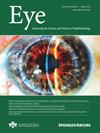Retinal fluid quantification using a novel deep learning algorithm in patients treated with faricimab in the TRUCKEE study
IF 2.8
3区 医学
Q1 OPHTHALMOLOGY
引用次数: 0
Abstract
Investigate retinal fluid changes via a novel deep-learning algorithm in real-world patients receiving faricimab for the treatment of neovascular age-related macular degeneration (nAMD). Multicenter, retrospective chart review and optical coherence tomography (OCT) image upload from participating sites was conducted on patients treated with faricimab for nAMD from February 2022 to January 2024. The Notal OCT Analyzer (NOA) algorithm provided intraretinal, subretinal and total retinal fluid for each scan. Results were segregated based on treatment history and fluid compartments, allowing for multiple cross-sections of evaluation. A total of 521 eyes were included at baseline. The previous treatments prior to faricimab were aflibercept, ranibizumab, bevacizumab, or treatment-naive for 52.3%, 21.0%, 13.3%, and 11.2% of the eyes, respectively. Of all 521 eyes, 49.9% demonstrated fluid reduction after one injection of faricimab. The mean fluid reduction after one injection was −60.7nL. The proportion of eyes that saw reduction in fluid compared to baseline after second, third, fourth and fifth faricimab injections were 54.4%, 51.9%, 51.4% and 52.2%, respectively. The mean (SD) retreatment interval after second, third, fourth and fifth faricimab injection were 53.4 (34.3), 56.6 (36.0), 57.1 (35.3) and 61.5 (40.2) days, respectively. Deep-learning algorithms provide a novel tool for evaluating precise quantification of retinal fluid after treatment of nAMD with faricimab. Faricimab demonstrates reduction of retinal fluid in multiple groups after just one injection and sustains this response after multiple treatments, along with providing increases in treatment intervals between subsequent injections.

在TRUCKEE研究中,使用一种新的深度学习算法对faricimab治疗的患者进行视网膜液定量。
背景:通过一种新的深度学习算法研究现实世界中接受faricimab治疗新生血管性年龄相关性黄斑变性(nAMD)患者的视网膜液变化。方法:对2022年2月至2024年1月期间接受法昔单抗治疗的nAMD患者进行多中心回顾性图表回顾和OCT图像上传。Notal OCT分析仪(NOA)算法为每次扫描提供视网膜内、视网膜下和视网膜总液。结果根据治疗历史和液体隔间进行分离,允许多个横截面评估。结果:基线时共纳入521只眼。在法利西单抗之前的治疗分别为阿非利塞普、雷尼单抗、贝伐单抗或初治,分别占52.3%、21.0%、13.3%和11.2%。在521只眼睛中,49.9%的眼睛在一次注射法利昔单抗后出现液体减少。一次注射后平均减液量为-60.7nL。在第二次、第三次、第四次和第五次法利西单抗注射后,与基线相比,眼液减少的比例分别为54.4%、51.9%、51.4%和52.2%。第二次、第三次、第四次和第五次法利西单抗注射后的平均(SD)再治疗间隔分别为53.4(34.3)、56.6(36.0)、57.1(35.3)和61.5(40.2)天。结论:深度学习算法为faricimab治疗nAMD后视网膜液的精确定量评估提供了一种新的工具。Faricimab在多组中仅注射一次后视网膜液减少,并在多次治疗后保持这种反应,同时在后续注射之间的治疗间隔增加。
本文章由计算机程序翻译,如有差异,请以英文原文为准。
求助全文
约1分钟内获得全文
求助全文
来源期刊

Eye
医学-眼科学
CiteScore
6.40
自引率
5.10%
发文量
481
审稿时长
3-6 weeks
期刊介绍:
Eye seeks to provide the international practising ophthalmologist with high quality articles, of academic rigour, on the latest global clinical and laboratory based research. Its core aim is to advance the science and practice of ophthalmology with the latest clinical- and scientific-based research. Whilst principally aimed at the practising clinician, the journal contains material of interest to a wider readership including optometrists, orthoptists, other health care professionals and research workers in all aspects of the field of visual science worldwide. Eye is the official journal of The Royal College of Ophthalmologists.
Eye encourages the submission of original articles covering all aspects of ophthalmology including: external eye disease; oculo-plastic surgery; orbital and lacrimal disease; ocular surface and corneal disorders; paediatric ophthalmology and strabismus; glaucoma; medical and surgical retina; neuro-ophthalmology; cataract and refractive surgery; ocular oncology; ophthalmic pathology; ophthalmic genetics.
 求助内容:
求助内容: 应助结果提醒方式:
应助结果提醒方式:


